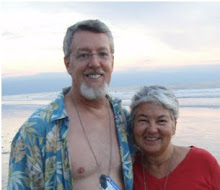Here Claudia is looking toward the narrow gorge that is the harbor entrance as we approached under power.

Janet and Paul's sailing blog can be found at http://baker-talos4.blogspot.com/. We shared a couple of dinners together, and tried some crab catching (unsuccessfully) before they headed north toward the Broughton Islands. We stayed another day at anchor in Gorge Harbor, so that we could hike across Cortes Island to Whaletown.
While I was figuring this out, the tidal current was moving us back toward the rocks. There was practically no wind, giving us no way to sail out of danger, so we rigged our inflatable dinghy. My initial effort to tow Sabbatical out of danger did not work very well. The tension of the tow line kept turning the dinghy--it was impossible to maintain the necessary heading. So we lashed the dinghy beside Sabbatical, fore and aft, so it could not turn. In this configuration we were able to make progress and get ourselves away from the rocks. Eventually, a light wind came up from the south, so we raised sails and slowly made our way back into Gorge Harbor, where we dropped anchor again, wondering how and where we could get a fanbelt. Here I am adding more coolant.

As it turned out, the problem was easily solved. At the Gorge Harbor Resort, we learned that a shuttle bus service called Cortes Express makes daily runs (via ferry) to Campbell River and that they will deliver parts from chandleries there. I was able to order the correct fan belt from a diesel supply place there and have them delivered to Gorge Harbor Resort the next afternoon.
The next morning we were on our way north again. On June 29, we passed through the tidal rapids at Beazeley Passage, and anchored in the Octopus Islands, a BC Marine Park. It was a beautiful area, but it rained hard for the next four days, keeping us mainly in the boat, and allowing us to discover some new leaks in our hatches and around our mast. The bad weather gave me time to work on some academic writing, so the time was not wasted. Shown below are some of the Octopus Islands during a break in the storm, and a picture of Claudia bundled up in the cockpit. It did not feel like summer.
While at Black's Lake, I was able to try out the new "pontoon shoes" I bought at West Marine. They worked surprisingly well in the fresh water. I highly recommend them. They are a little awkward at first, until you get used to sliding them forward. It feels more like ice skating than walking. But it is very fun to be able to "stroll" over to nearby boats.
From Roscoe Bay, we moved north to Pendrell Sound, one of our favorite places from last summer. But it started raining again, hard. Once again, we spent most of our time in the boat rather than outside. But I got some more writing done. At one point we snagged an oyster net in our propeller. I had to dive into the cool water with a knife to get it off.
After three days of rain we were ready to get out of Pendrell Sound, so we motored south toward Prideaux Haven. Rain was pouring down hard enough to teach me the limitations of some of our foul weather gear. Some lightweight rain pants that claimed to be water resistant didn't resist for long. I was soaked by the time we anchored in Melanie Cove.
At Melanie Cove it continued to rain, but we managed to do some kayaking and hiking anyway. While hiking from Melanie Cove to Unwin Lake, we spotted a Great Grey Owl. According to Claudia's bird watching books it was well outside its normal range.
Here is Claudia looking down on Double Island at the entrance to Toba Inlet. We hiked to this spot from the Toba Wilderness Resort, where we stopped for fresh water.
More later....

































































